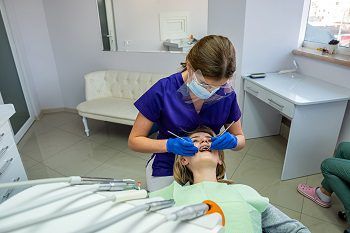Deep Teeth Cleaning And How It Works

Deep teeth cleaning becomes necessary when a patient has a significant amount of tartar or plaque buildup below the gum line and in the roots of the teeth. In most cases, the patient also suffers from periodontal disease, which significantly impairs the health of gums.
Gums pull away from the teeth, resulting in a gap between the teeth and gums. This space, in turn, makes deep pockets inside the patient's mouth, and his oral health is severely affected.
Dental deep teeth cleaning provides numerous benefits to the patients. For instance, it stops gum disease progression and helps fight bad breath. It also promotes healthy gums and protects the roots of the teeth.
Dental deep cleaning consists of systematic steps to carry out the procedure, i.e., oral examination, addressing the issue, teeth scaling, and root planing.
Working Principles of Scaling
Deep teeth cleaning involves two techniques, known as teeth scaling and root planing. Teeth scaling removes excess buildups in the patient's mouth, like tartar and plaque. It is removed by gently scraping the tool below the patient's gumline and along with the tooth. The dentist might use an electronic scaler to do this process. The electronic scaler has a vibrating metal tip that chips away tartar or plaque. It is also accompanied by a water spray to wash away any debris found in the patient's mouth.
Tooth scraping is usually not painful, but the patient might experience a little discomfort, especially after the procedure. Mostly, the area is numbed during the procedure so that the patient can avoid unpleasant feelings.
Teeth scaling leads to better gum health, and patients can avoid conditions like halitosis. The scraping procedure in teeth scaling removes tartar, plaque, and any excess buildups, otherwise leading to stained teeth. Teeth scaling uses an air polisher to polish the teeth and make them bright and shiny. This procedure also helps to reduce the prevalence of gum disease by eliminating all forms of bacteria from the mouth.
Working Principles of Root Planing

Root planing is done to protect the teeth' roots and eliminate all forms of plaque and tartar accumulation. It is a non-surgical procedure but mostly uses local anesthesia to numb the patient's mouth and ease the process. Root planing focuses on smoothing the rough surfaces of the affected teeth by removing subgingival bacteria. During this procedure, the dentist removes tartar and plaque under the gum line and within the teeth's roots. Planing completely removes the cementum that covers the tooth roots and is known as a calcified film. Dentin, i.e., the second layer of the tooth below the enamel, can also be removed during the procedure.
Root planing helps to reattach the gums with the teeth by reducing the space caused due to dental pockets. It ensures better oral health by removing bacterial toxins below the gum line or in the roots.
Final Thoughts
We hope that you have benefitted from the above set of information. If you require deep dental cleaning, do not hesitate to talk to your dentist. Schedule an appointment today to improve your oral health and smile with confidence.
Contact your Pinole dentist, Dr. Hoss Abar, DDS, MSD at Abar Orthodontics to schedule an appointment for deep teeth cleaning.
*Neither this nor any other content in this media is meant to prescribe, recommend, or prevent any treatment or procedure. We highly recommend that you get the advice of a qualified dentist or other medical practitioners regarding your specific dental condition.
More To Explore
About Us
We believe that every patient deserves to feel confident about their smile. Years of experience creating beautiful and flawless smiles.
Opening Hours:
Monday - Thursday: 8:00 AM - 5:00 PM
Friday: 8:00 AM - 12:00 PM
Saturday - Sunday: Closed
Abar Orthodontics, Pinole, CA
1500 Tara Hills Drive., Suite 204
Pinole, CA 94564
Abar Orthodontics, San Leandro, CA
145 East 14th street., #100
San Leandro, CA 94577
© 2025Abar Orthodontics | All rights reserved | Powered by:Vigorant, Inc.
